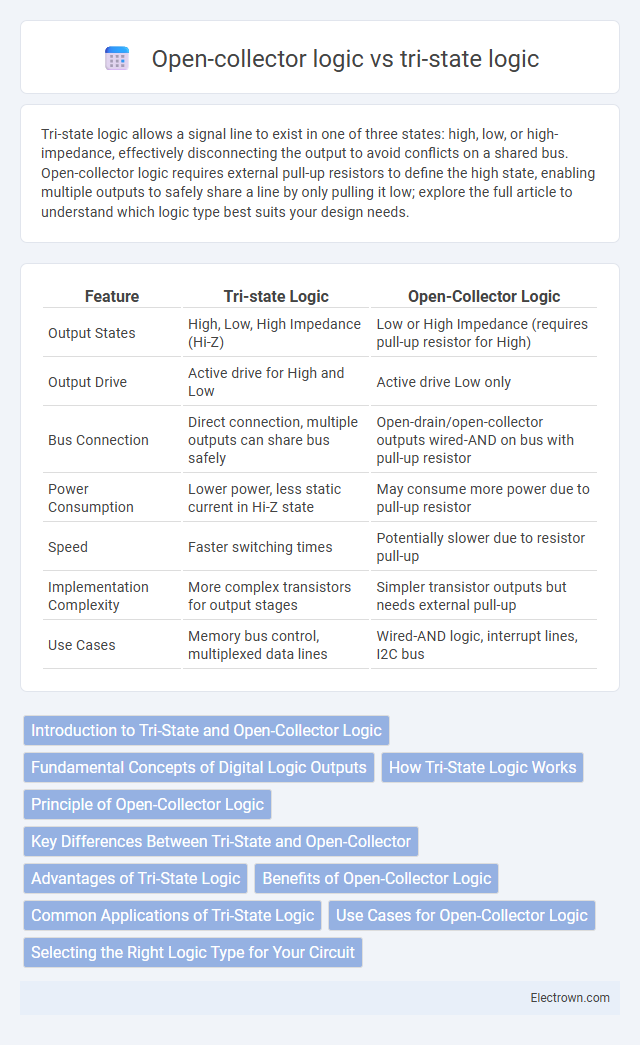Tri-state logic allows a signal line to exist in one of three states: high, low, or high-impedance, effectively disconnecting the output to avoid conflicts on a shared bus. Open-collector logic requires external pull-up resistors to define the high state, enabling multiple outputs to safely share a line by only pulling it low; explore the full article to understand which logic type best suits your design needs.
Table of Comparison
| Feature | Tri-state Logic | Open-Collector Logic |
|---|---|---|
| Output States | High, Low, High Impedance (Hi-Z) | Low or High Impedance (requires pull-up resistor for High) |
| Output Drive | Active drive for High and Low | Active drive Low only |
| Bus Connection | Direct connection, multiple outputs can share bus safely | Open-drain/open-collector outputs wired-AND on bus with pull-up resistor |
| Power Consumption | Lower power, less static current in Hi-Z state | May consume more power due to pull-up resistor |
| Speed | Faster switching times | Potentially slower due to resistor pull-up |
| Implementation Complexity | More complex transistors for output stages | Simpler transistor outputs but needs external pull-up |
| Use Cases | Memory bus control, multiplexed data lines | Wired-AND logic, interrupt lines, I2C bus |
Introduction to Tri-State and Open-Collector Logic
Tri-state logic allows a signal to exist in one of three states: high, low, or high-impedance, enabling multiple devices to share a common bus without signal interference. Open-collector logic uses transistors with outputs that can either sink current or be left floating, relying on external pull-up resistors to define the high state. Both methods facilitate bus sharing but differ in implementation and control of output signals, with tri-state devices actively driving the line to high or low, while open-collector outputs passively pull the line low or leave it floating.
Fundamental Concepts of Digital Logic Outputs
Tri-state logic outputs can exist in three states: high, low, and high-impedance, allowing multiple devices to share a common bus without interference. Open-collector logic uses a transistor to pull the line low or leave it floating, requiring an external pull-up resistor for the high state and resulting in simpler wired-AND configurations. Understanding the fundamental differences helps you choose the right output type for bus contention management and signal integrity in digital circuits.
How Tri-State Logic Works
Tri-state logic operates by allowing a digital output to exist in one of three states: high (1), low (0), or high-impedance (Z), which effectively disconnects the device from the circuit. This high-impedance state enables multiple outputs to share a common bus without interference, as only one device drives the line at a time while others remain electrically isolated. Understanding how tri-state logic works is essential for implementing efficient bus communication in digital systems, preventing signal contention and ensuring data integrity.
Principle of Open-Collector Logic
Open-collector logic uses transistors with the collector terminal left open, allowing multiple outputs to be wired together to form a wired-AND configuration. This principle enables passive pull-up resistors to pull the line high when no transistor is conducting, facilitating bus communication without bus contention. Unlike tri-state logic, open-collector outputs cannot actively drive the line high, relying solely on external components for the high state.
Key Differences Between Tri-State and Open-Collector
Tri-state logic allows an output to exist in one of three states: high, low, or high-impedance, enabling multiple devices to share a common bus without interference. Open-collector logic, commonly used in wired-AND configurations, sinks current to ground when active but relies on external pull-up resistors to define the high state. Your choice between these logics depends on whether you require true signal isolation in the high-impedance state or simple wired-AND functionality with external voltage control.
Advantages of Tri-State Logic
Tri-state logic offers significant advantages in reducing circuit complexity by allowing multiple outputs to share a common bus without interference, thanks to its three output states: high, low, and high-impedance. This high-impedance state effectively disconnects the device from the bus, preventing contention and enabling efficient multiplexing. Compared to open-collector logic, tri-state logic provides faster switching speeds and lower power consumption, enhancing overall system performance.
Benefits of Open-Collector Logic
Open-collector logic enables multiple outputs to share a single line for wired-AND configurations, simplifying circuit design and reducing the number of required components. It provides increased noise immunity and allows for easy implementation of level shifting and interfacing with different voltage levels. Your systems benefit from enhanced fault tolerance since open-collector outputs can be safely connected without risking damage from output contention.
Common Applications of Tri-State Logic
Tri-state logic is commonly used in bus systems, memory devices, and microprocessor data lines where multiple devices share a common connection without interference. Its ability to present a high-impedance state enables seamless multiplexing and prevents signal contention on shared communication lines. Understanding these applications helps you design efficient circuits with controlled data flow and minimized power consumption.
Use Cases for Open-Collector Logic
Open-collector logic is ideal for wired-AND configurations in bus systems where multiple devices share a common communication line, allowing any device to pull the line low without causing damage. It is frequently used in interrupt lines and fault detection circuits to ensure reliable signaling and prevent contention between outputs. This logic type supports voltage level shifting and isolation, making it suitable for interfacing devices operating at different voltage levels.
Selecting the Right Logic Type for Your Circuit
Choosing between tri-state logic and open-collector logic depends on your circuit's bus requirements and signal control needs. Tri-state logic offers three output states--high, low, and high-impedance--enabling multiple devices to share a common bus without interference. Open-collector logic requires external pull-up resistors and is ideal for wired-AND configurations or when interfacing with different voltage levels, but it generally results in slower signal transitions compared to tri-state buffers.
Tri-state logic vs open-collector logic Infographic

 electrown.com
electrown.com